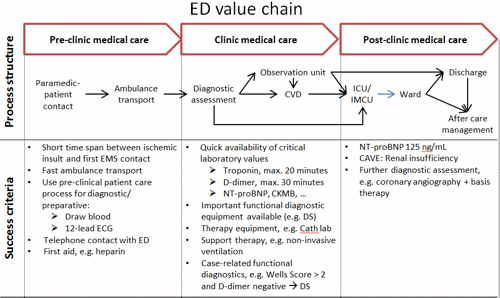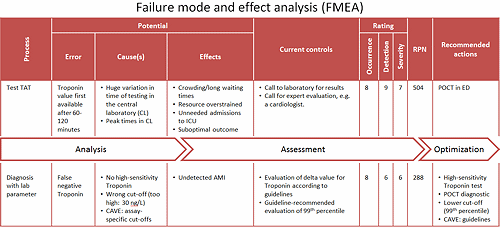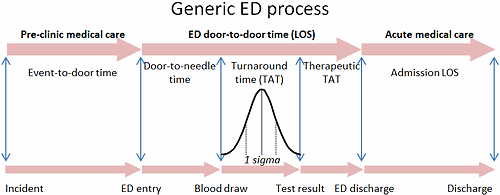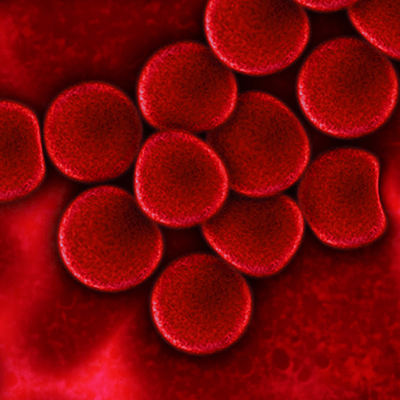Printed from acutecaretesting.org
January 2012
POCT in the ED - relevant clinical and economical advantages
BACKGROUND
Currently, budget cuts associated with an increased pressure on resources (staff, consumables, techniques, equipment) force hospitals to optimize clinical processes with the aim to reduce costs while increasing treatment quality (paradigm shift in hospital management appreciation).
Evaluation of clinical process performance is based on:
- Door-to-door time/waiting time
- Quality (complications, infections, retransfer)
- Resource consumption
- Outcome
- Costs (direct and indirect costs, opportunity and intangible costs)
- Errors/error proneness
- Risks (probability, detection and consequence for patient by occurrence)
The primary reason for errors is a result of variability in subprocesses, especially in exceptional situations, common in emergency departments. Thus, the quality of the ED process becomes evident by evaluating its robustness, predictability and controllability.
POCT technologies play an important quality-enhancing, risk-reducing and economic role in the patient management because reliable laboratory results are central to the crucial step of treatment decision. For the ED, the use of POCT raises the following questions:
- Can a POCT process reduce the variance in the laboratory turnaround time (TAT)?
- Is an improved ease of scheduling of the diagnostic process (process stability) connected to quality and patient outcome?
- Would a faster response time for specific laboratory values reduce bottlenecks in special diagnostic areas in the ED (e.g. CT scanning) and reduce pressure on staff and medical equipment resources, and thereby reduce overall costs in the patient care process?
- How clinically relevant is a shorter laboratory TAT for D-dimer, TSH, natriuretic peptides, cardiac troponins, lactate and creatinine?
- Is the laboratory TAT a bottleneck for diagnostic and therapeutic process, and would a reduced TAT with less variance reduce errors in patient management?
THE PURPOSE OF THE ED
The question about economic and medical-emergency functionality of the ED is of particular importance because 30-50 % of all hospitalized patients are admitted through the ED.
The ED is gatekeeper and an organizational hub between ambulatory and stationary patient care. The ED is also the first point of contact for patients with various complaints: from non-hazardous injuries to patients with life-threatening diseases (stroke, acute myocardial infarction, embolism).
Hence, the ED provides a coordination of various medical disciplines to support the best possible diagnosis, initiate treatment, and decides on further patient management (admission/discharge).
ORGANIZATIONAL AND TECHNOLOGICAL PERFORMANCE LEVERS IN THE ED
The requirements for best economic practices in the ED’s patient care process are linked to a few success criteria:
(a) The lever “Process integration and connectivity”
The ED is as a coordination hub between emergency medical services (EMS) and inpatient follow-up. Therefore, it is imperative for the ED to coordinate each phase of the emergency treatment chain so that the patient immediately receives the correct and best care.
An important success criterion for the ED is to have a communication line between the ED and EMS. The better the ambulance crew handles stroke, heart attack or trauma patients, the earlier relevant, precise information can arrive in advance of the patient to the ED.
Experience from the AMI network Bad Nauheim (Germany) shows that when the paramedics perform 12-lead EKG during transport (telemedicine) and draw blood, then the time between the first contact between the patient and the rescue team until revascularization (contact-to-balloon time) is less than 3 hours, and the door-to-balloon time less than 90 minutes (Fig. 1).

FIG. 1: Close interaction between pre-clinical, clinical, and post-clinical patient process care as a lever for quality and cost effectiveness . When using POCT, the diagnostic assessment time can be considerably reduced, leading to better patient management (no waiting time for the patients and no faulty bed occupancy)
(b) The lever “Triage, observation and chest-pain units”
A dedicated triage area, the implementation of an observation area and chest-pain unit ensure that the following problems in the treatment process can be avoided:
- Patient admissions with imprecise diagnosis because of time pressure (approximately 25 % of the angina pectoris patients admitted as suspected acute myocardial infarction (AMI) have a non-coronary-caused disease).
- Unnecessary secondary patient transport between departments.
- Delays in the diagnosis and therapy because of unavailable technical equipment (MRT, CT scanner) and consulting physicians from other departments.
- Missing bed capacity at the observation unit, leading to blockade of examination/treatment beds or a too early transfer to other hospital departments.
- Disturbance of stationary patients because of admissions to the wards during the night.
- Use of ICU beds instead of early, minimal-invasive ventilation (additional costs: 1,200-1,500 €/day).
(c) The lever “POCT technologies in the ED”
The NAPOC study, conducted in our department, investigated POCT technologies in EDs. We questioned whether a faster TAT and knowledge of the exact time point of result availability for clinically important parameters reduce pressure on staff, medical equipment, functional diagnostics and intensive care units, thus reducing overall costs of the patient care process (Fig. 2).

FIG. 2: Failure mode and effects analysis (FMEA). The FMEA provides a systematic prospective risk analysis and risk assessment of clinical processes (NAPOC study/von Eiff, 2011). It includes analysis of errors in the process, especially those that affect the patient, and can be potential or actual. Effects analysis refers to studying the consequences of those failures, and optimization looks at potential process changes. Rating: Occurrence (probability of occurrence; 1 = not plausible, 10 = highly likely), detection (chance of discovery; 1 = certain, 10 = undetected), severity (damage to patient; 1 = no effect, 10 = hazardous).
Risk-cost analysis of different organizational formats and concepts of patient management in the ED shows that the use of laboratory parameters for critical illness (amongst others cardiac troponins, βHCG, D-dimer, procalcitonin and NT-proBNP) increases medical quality of the treatment.
In addition, we see that faster availability of these clinically important parameters leads to better patient outcome and less costs of patient care.
The laboratory subprocess, the test quality and TAT are a crucial success factor for treatment quality, patient satisfaction and costs of emergency management and post-emergency care (Fig. 3).

FIG. 3: Generic ED process. The sketch shows process parameters and phases that are critical for quality and results. The laboratory process in the ED has a large potential for disruption, because TAT variances determine the clinical and economic success of the ED.
POCT provides the fastest possible way to determine parameters such as troponin I/T, BNP/NT-proBNP, D-dimer and lactate. Troponin and lactate carry strong prognostic value in addition to their well-known diagnostic value.
In our NAPOC study, we compared the turnaround time (TAT) for clinically important laboratory parameters in various ED settings:
-
ED with POCT (immunoassay analyzer)
-
Centralized laboratory in the hospital
-
Laboratory not on the premises of the hospital (external laboratory)
Obtaining natriuretic peptides in 20-35 minutes enables the physician to quickly clarify if dyspnea is of pulmonary or cardiac origin, and in the case of cardiac origin, assess the severity of heart failure.
The waiting time for functional diagnostic tests and x-ray lags significantly behind. This POCT-supported risk evaluation replaces the time-intensive echocardiography (ideally 10 minutes, normally 2-3 hours) and thus supports a decision for the early discharge to out-hospital care.
Another bottleneck in the ED is TSH TAT. TSH is a decision criterion for the use of imaging procedures and the TAT is 60-90 minutes from the central laboratory; hence, it would be desirable to have a qualitative TSH result from POCT technologies in 20 minutes.
Creatinine values are used for the assessment of renal function and for determination of contrast-agent compatibility and is available with POCT after 2 minutes.
D-dimer, in conjunction with Wells score, can be used as a screening test to identify patients with suspected thrombosis that should have a Doppler examination. POCT D-dimer with a TAT of 20 minutes leads to reduced patient crowding in the ED monitoring area.
For the care of NSTEMI patients, the availability of Troponin I after 18-20 minutes (Troponin T values after 12 minutes) is of considerable clinical and economic relevance.
Sensitive POCT cardiac troponin assays minimize the risk of an undetected AMI (especially in women) and the length of stay (LOS) in the ED per AMI patient is reduced from 5.00-5.30 hours to 4.20-4.30 hours with POCT.
For the ED, the consequences of implementing POCT are a reduction of LOS of AMI patients of 40-60 minutes and optimization of the use of the examination/treatment beds. POCT reduces the risk of transferring patients to the ICU where the daily costs per bed lies between 1,000 and 1,200 €.
In addition, patients receive individually targeted treatment earlier; an important step for better outcome.
The NAPOC study also shows that POCT technology improves the ED physicians’ control of the diagnosis processes and makes it easier to schedule the next medical steps.
The variance of TAT for Troponin T is reduced to 13-34 minutes with POCT compared to 40-60 minutes with a centralized laboratory.
Sensitive POCT diagnostics support areas where other (preceding) methods of diagnostics do not identify all who require medical care. For example, 10-20 % AMI patients have non-specific 12-lead ECG changes.
However, the findings in the NAPOC study showed that the full rationalization potential of POCT is not reached by implementation of POCT alone, as other processes in the ED can negate POCT (confounding factors).
This finding was also demonstrated by Renaud et al [1]. In that study, POCT reduced the TAT of cardiac troponin with 71 minutes; however, patient LOS was almost identical between the two settings.
In their setting the lack of an observation/chest-pain unit was probably the reason for identical LOS. Ultimately, it can be expected that POCT in conjunction with other structure- and process-optimization measures can reduce the capacity needs in the ED by 25-28 %.
CONCLUSIONQuality and efficiency of emergency care depends directly on a timely laboratory result. The proportion of the laboratory medicine in the diagnostic process is as high as 70 %.
For shortening the laboratory TAT, time- and therapy-critical parameters can be advantageously determined with POCT devices. The effects are multiple and include reduction in patient waiting time before start of treatment, with a direct impact on diagnosis.
An ED with POCT needs less monitoring capacity. Additionally, improved diagnosis and treatment decisions relieve the ICU and intermediate care departments.
The question of the economic benefits of investing in POCT technology is not answered by simply comparing the cost per sample; a thorough and complete view of treatment-quality demands and timing of diagnosis, total process costs and patient risks is necessary to properly assess the cost-benefit of the decision of implementing POCT in an ED.
For the ED, POCT is the autonomous, diagnostically relevant laboratory process for time-sensitive parameters (e.g. troponin I/T, CKMB, D-dimer). Here, the POCT technology can increase patient safety by accelerating diagnostic and therapeutic processes, while reducing costs, in particular those associated with functional diagnostic methods.
The rapid availability of important laboratory parameters allows the optimal use of such resources, e.g. by reducing their use as simple screening methods.
Thus, POCT positively influences patient risks, patient satisfaction, medical outcome and process costs in the ED.
Other crucial success criteria in emergency care are the process integration and connectivity between pre- and post-emergency care facilities and the integration of observations/chest-pain units.
References
- Renaud B, Maison P, Ngako A, Cunin P, Santin A, Hervé J, Salloum M, Calmettes M, Boraud C, Lemiale V, Grégo JC, Debacker M, Hémery F, Roupie E. Impact of point-of-care testing in the emergency department evaluation and treatment of patients with suspected acute coronary syndromes. Acad Emerg Med 2008; 15: 216-24.
References
- Renaud B, Maison P, Ngako A, Cunin P, Santin A, Hervé J, Salloum M, Calmettes M, Boraud C, Lemiale V, Grégo JC, Debacker M, Hémery F, Roupie E. Impact of point-of-care testing in the emergency department evaluation and treatment of patients with suspected acute coronary syndromes. Acad Emerg Med 2008; 15: 216-24.
May contain information that is not supported by performance and intended use claims of Radiometer's products. See also Legal info.
Register for the related webinar
The Benefit of Using a D-dimer Assay with a High Clinical Specificity
Presented by Karin Strandberg, MD, PhD, Assoc. Prof.
Join the webinarAcute care testing handbook
Get the acute care testing handbook
Your practical guide to critical parameters in acute care testing.
Download nowScientific webinars
Check out the list of webinars
Radiometer and acutecaretesting.org present free educational webinars on topics surrounding acute care testing presented by international experts.
Go to webinars









